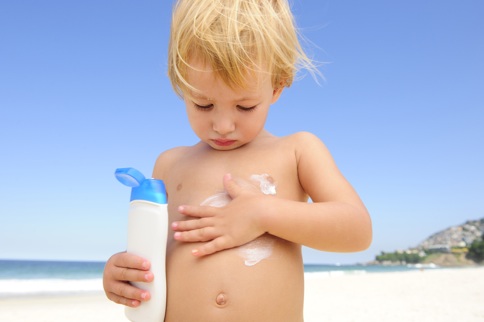A new study published in the journal Environmental Science and Technology, found that nano zinc oxide – used in many sunscreens and some toothpastes and beauty products—makes sea urchin embryos much more vulnerable to other environmental toxins. Nano-copper oxide found in boat paint had the same effect. The research follows other recent studies that have shown that nano sunscreen ingredients can harm coral and phytoplankton – which are the basis for the entire marine food chain.
Researchers took white sea urchin embryos, which are highly sensitive to toxic materials, and exposed them to various quantities of nano zinc oxide and copper oxide.
“Both of these nanomaterials are nontoxic to cells at low levels,” said coauthor Gary Cherr, a professor and interim director of the University of California’s Davis Bodega Marine Laboratory. “But even at low levels, where these kind of materials are not toxic to the embryos themselves, they can act as what we call chemosensitizers.”
Embryo cells expel toxins through a series of tiny pumps. But when nanomaterials inside the cells begin to dissolve, they overwhelm the pumps and allow other harmful environmental chemicals to enter the cells and remain there. The results can be devastating.
“If you expose them to a concentration of one of these other toxic chemicals, you might have 50 percent of the cells developing normally and 50 percent dying or being abnormal,” Cherr said. “And then you add nanomaterials, and suddenly that goes down to only 10 percent developing normally.”
At higher concentrations, the nanomaterials themselves can halt embryo development. Furthermore, the tiny particles are not just harmful to sea urchins.
“Embryos and larvae from a variety of different marine and aquatic organisms all have a significant amount of these pumps that protect them from environmental chemicals,” Cherr said. “We assume they would be affected in the same way.”
Such chemosensitisation may also affect adult fish, Cherr added, because their gills contain large concentrations of the detoxifying pumps.
Zinc oxide has been used in sunscreens for generations, but the nano-zinc formula was only introduced in the past decade, Cherr said.
The nano-zinc in sunscreen – even in waterproof products – washes off into the water when sunbathers go for a swim.
Several studies are now under way in Europe to determine how much nano-zinc enters the water. “In some places there are tens of thousands of bathers in shallow coves in the summertime,” Cherr said. “There are some early indications that [nano-zinc levels] could be quite significant.”
Unfortunately, since nano-ingredients in sunscreen do not have to be labelled in Australia consumers have no way knowing if their sunscreen contains nano-ingredients or not. To make matters worse, a number of sunscreen ingredient companies have been marketing nano-ingredients as non-nano – and the ACCC has made it clear they don’t intend to do anything about it – leaving us well and truly in the dark. In Europe, nano-ingredients in sunscreen and cosmetics have been labelled since 2013.
Nano-copper oxide, meanwhile, was introduced to boat paint over the last few years. Copper prevents the accumulation of mussels and barnacles on the bottom of boats.
Traditional copper-based paint for boats sheds more of the toxic metal than the nano-copper formula, which does not have to be applied to boat bottoms as often. But nano-copper also appears to cause chemosensitisation in sea urchin embryos. Scientists are now trying to develop copper-free paint formulas.
Despite a growing body of evidence that nanomaterials released into water, soil or the marine environment have potentially significant impacts, not a single measure has been taken in Australia to address the currently unrestricted release of nanomaterials into the environment.
Source: Kirby, D. (2015) The Tiny but Toxic Ingredient in Your Sunscreen, TakePart


